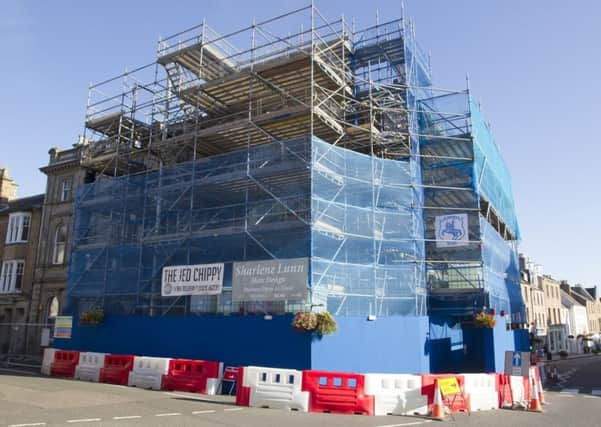The only way is down for Jedburgh building despite objections mounting, townsfolk told


Another objection to the local authority’s application for planning consent to pull down the four-storey corner property at High Street and Exchange Street was received this week.
However, the town’s community council has been told there is no plan B and that the building, shrouded in scaffolding for the last four years, must come down.
Advertisement
Hide AdAdvertisement
Hide AdTown councillor Jim Brown told last week’s meeting: “The building will be rebuilt by Scottish Borders Council with funding from the council and Historic Environment Scotland. It will be demolished and the building next to it made safe.
“Hopefully, there’ll be some funding available to help with the dry rot, which has moved into the building next door, as it’s a major issue too.
“The building that replaces it will be of a similar design and handed over to a registered social landlord.
“It was obvious it was never going to be a simple problem to solve.
Advertisement
Hide AdAdvertisement
Hide Ad“I don’t think there is any question that it will not come down.”
Looking ahead, he added: “I think we are still in negotiations with one of the owners, and it takes a long time to get these compulsory purchases.
“The council is bending over backwards to get a deal here.
“What they are hoping to achieve is, one way or another an agreement face to face or the compulsory purchase, and hopefully that’ll happen by the end of this year, with demolition to follow next year.
“I know it’s dragged on, but that’s the way it is.”
His update came just days before a formal objection to the planning application was lodged by London-based Save Britain’s Heritage.
Advertisement
Hide AdAdvertisement
Hide AdIt criticised the council’s failure to find out the building’s current market value and said it should not be abandoning the site.
Mark Afford, a spokesman for the organisation, said: “The setting itself requires the highest standards of protection and an exhaustive attempt to find viable solutions.
“We do not believe that search should be abandoned at this stage.
“It is our opinion that the proposal to demolish this category-C listed building should be refused. The current application falls short of satisfying local and national planning policy, and the character and integrity of Jedburgh should be safeguarded.
Advertisement
Hide AdAdvertisement
Hide Ad“The total loss of 2 High Street would be hugely regrettable. Buildings of this age are often irreplaceable.
“We fear that the continuing inconvenience and appearance of the scaffolding are driving decision-making, rather than established policy.
“Although the description of eyesore may be momentarily apt, it applies simply to the current scaffolding, not the building.
“A demolition followed by an undeveloped gap, followed in turn by an almost inevitably inferior new build will not improve local aesthetics.
Advertisement
Hide AdAdvertisement
Hide Ad“The importance of the setting of this building demands all efforts be made to find a solution which retains the asset, and we believe the planning authority are justified in mounting a robust defence of designated assets and the historic character of Jedburgh.”
Those sentiment were shared by community councillor Brian Woods last week, and he said: “Why take it down to rebuild it and put it back up with a big space in the middle of the town that will haggle on and then ask what are we going to do with it?
“I really harmonise with the fact that it has cost too much to keep it up, why not keep it up and get on with it rather than bring added cost to the situation.”
Other members of the community council agreed demolition was the only viable way forward, though.
Advertisement
Hide AdAdvertisement
Hide AdAnd Historic Environment Scotland says it will not oppose the demolition bid.
In a written response to the council, it says: “It should be demonstrated that all reasonable efforts have been made to retain the listed building, which should also include the marketing of a building.
“In reviewing the supporting information, we consider it is a reasonable conclusion that the retention and reuse of the building is not going to be economically viable.”